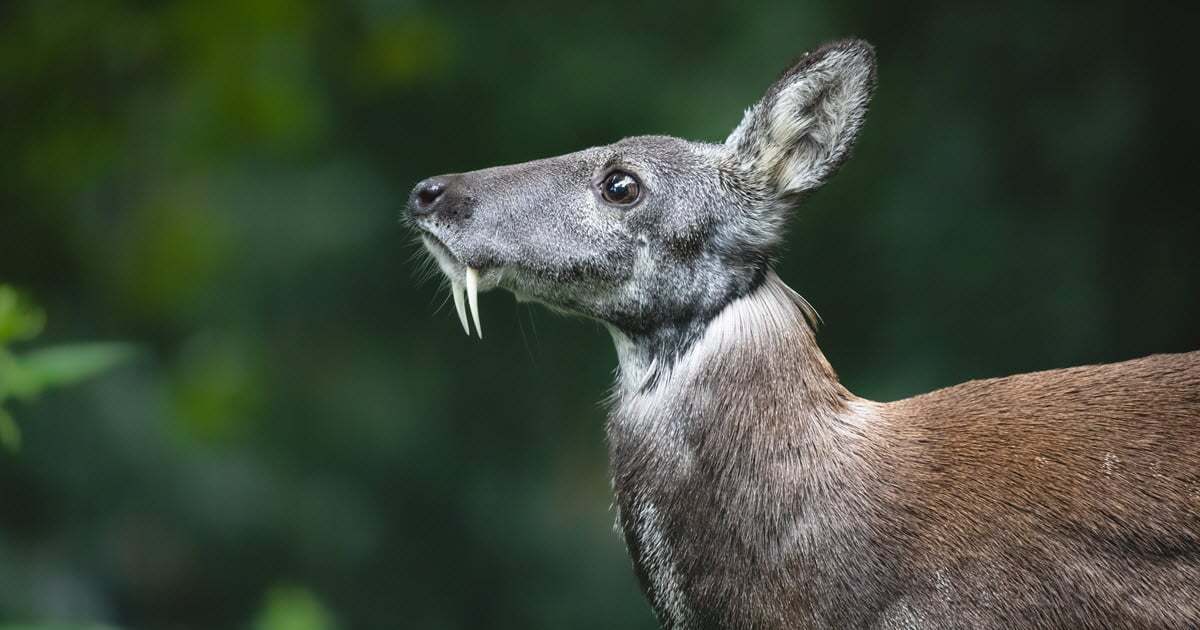
Ever heard of a deer with fangs? Meet the vampire deer, a creature that sounds like it stepped out of a fairy tale. Unlike your typical deer, these unique animals sport long, sharp canine teeth that resemble vampire fangs. Found in parts of Asia, particularly in China and Korea, vampire deer are actually musk deer. Their fangs are used not for blood-sucking but for fighting and attracting mates. These fascinating creatures are small, elusive, and have a mysterious aura that captivates wildlife enthusiasts. Ready to dive into 35 intriguing facts about these fang-tastic animals? Let's get started!
Key Takeaways:
- Vampire deer, also known as musk deer, have long fang-like tusks and are found in Asia. They are small, solitary, and have unique adaptations to survive in their mountainous habitats.
- Vampire deer face threats from hunting and habitat loss, leading to declining populations. Conservation efforts, including captive breeding programs, are underway to protect these unique creatures.
What Are Vampire Deer?
Vampire deer might sound like creatures from a horror movie, but they're real animals with fascinating features. These deer have earned their spooky name due to their long, fang-like tusks. Let's dive into some intriguing facts about these unique creatures.
-
Vampire deer are also known as musk deer. These deer belong to the Moschidae family and are found in Asia, particularly in the Himalayas, Siberia, and Korea.
-
They have long canine teeth. Unlike other deer species, male vampire deer have elongated canine teeth that can grow up to 3 inches long. These tusks are used for fighting during mating season.
-
Musk deer are small. They are much smaller than typical deer, standing only about 20-28 inches tall at the shoulder.
-
They lack antlers. Unlike most deer species, vampire deer do not have antlers. Instead, they rely on their tusks for defense and competition.
-
Musk deer are solitary animals. They prefer to live alone and are highly territorial, marking their territory with musk.
Habitat and Distribution
Understanding where vampire deer live and how they adapt to their environment can provide insight into their behavior and survival strategies.
-
They inhabit mountainous regions. Vampire deer are commonly found in rugged, mountainous areas with dense vegetation.
-
They are adapted to cold climates. These deer have thick fur to keep them warm in the harsh climates of their mountainous habitats.
-
Vampire deer are elusive. They are shy and secretive, making them difficult to spot in the wild.
-
They are excellent climbers. Their strong legs and hooves allow them to navigate steep and rocky terrain with ease.
-
Musk deer are nocturnal. They are most active at night, which helps them avoid predators and human activity.
Diet and Feeding Habits
Vampire deer have unique feeding habits that help them thrive in their specific environments.
-
They are herbivores. Vampire deer primarily eat leaves, grasses, mosses, and lichens.
-
They have a specialized diet. In winter, they rely on a diet of lichens and mosses, which are abundant in their cold habitats.
-
They have a four-chambered stomach. Like other ruminants, vampire deer have a complex stomach that helps them digest tough plant material.
-
They are selective feeders. These deer carefully choose their food, often preferring high-nutrient plants.
-
Musk deer help with seed dispersal. By eating fruits and plants, they play a role in spreading seeds throughout their habitat.
Reproduction and Lifespan
The reproductive habits of vampire deer are as unique as their appearance.
-
Breeding season is in winter. Vampire deer typically mate during the winter months.
-
Males compete for females. During mating season, males use their tusks to fight for the attention of females.
-
Females give birth to one fawn. After a gestation period of about six months, females usually give birth to a single fawn.
-
Fawns are well-camouflaged. Newborn fawns have spotted coats that help them blend into their surroundings.
-
Lifespan is around 10-14 years. In the wild, vampire deer can live up to 14 years, though many do not reach this age due to predation and habitat loss.
Conservation Status
Vampire deer face several threats that have led to their declining populations.
-
They are hunted for their musk. Musk deer are often hunted for their musk glands, which are highly valued in traditional medicine and perfumery.
-
Habitat loss is a major threat. Deforestation and human encroachment have significantly reduced their natural habitats.
-
They are listed as vulnerable. The International Union for Conservation of Nature (IUCN) lists several species of musk deer as vulnerable due to declining populations.
-
Conservation efforts are underway. Various organizations are working to protect musk deer through habitat preservation and anti-poaching measures.
-
Captive breeding programs exist. Some zoos and wildlife reserves have breeding programs to help increase musk deer populations.
Interesting Behaviors
Vampire deer exhibit several behaviors that make them stand out among other deer species.
-
They communicate through scent. Musk deer use scent glands to mark their territory and communicate with other deer.
-
They are agile jumpers. These deer can leap great distances to escape predators or navigate their rocky habitats.
-
They have a keen sense of smell. Their strong sense of smell helps them locate food and detect danger.
-
They are silent movers. Vampire deer move quietly through their environment to avoid attracting attention.
-
They are cautious drinkers. When drinking from streams or rivers, they remain alert and ready to flee at the first sign of danger.
Unique Adaptations
The physical and behavioral adaptations of vampire deer help them survive in their challenging environments.
-
They have large ears. Their big ears help them detect sounds from predators and other threats.
-
Their fur changes with the seasons. In winter, their fur becomes thicker and darker to provide better insulation and camouflage.
-
They have a unique dental structure. Besides their long canines, vampire deer have specialized molars for grinding tough plant material.
-
They can swim. Although not commonly seen, vampire deer are capable swimmers and can cross rivers if necessary.
-
They have a high-pitched alarm call. When threatened, they emit a high-pitched whistle to warn other deer of danger.
The Final Bite
Vampire deer, with their fang-like tusks and elusive nature, are truly fascinating creatures. Found in parts of Asia, these deer have adapted to their environments in unique ways. Their tusks, used mainly for mating battles, set them apart from other deer species. Despite their name, they don't drink blood; instead, they feed on plants and small animals.
These deer face threats from habitat loss and hunting, making conservation efforts crucial. Learning about vampire deer helps us appreciate the diversity of wildlife and the importance of protecting it. Next time you hear about vampire deer, you'll know they're more than just a spooky name. They're a testament to nature's incredible adaptability and resilience. Keep exploring the wonders of the animal kingdom, and you'll always find something new and amazing.
Frequently Asked Questions
Was this page helpful?
Our commitment to delivering trustworthy and engaging content is at the heart of what we do. Each fact on our site is contributed by real users like you, bringing a wealth of diverse insights and information. To ensure the highest standards of accuracy and reliability, our dedicated editors meticulously review each submission. This process guarantees that the facts we share are not only fascinating but also credible. Trust in our commitment to quality and authenticity as you explore and learn with us.


